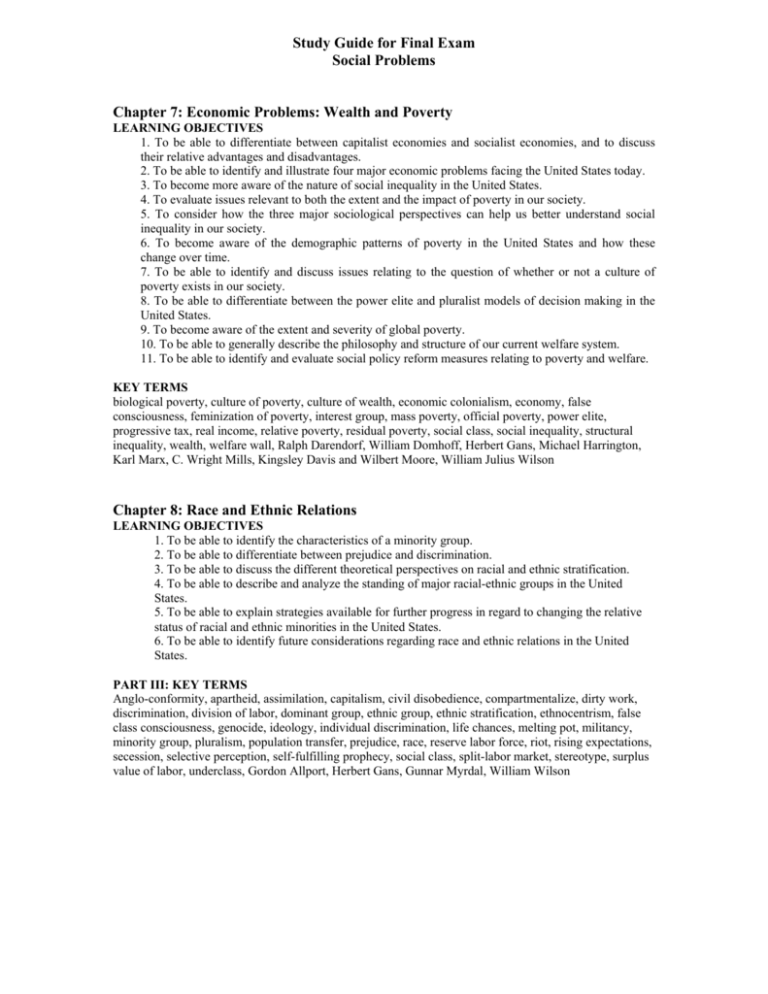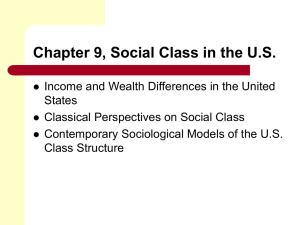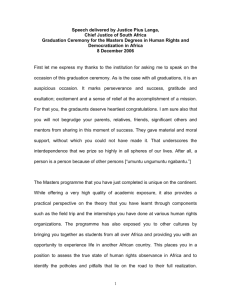Study Guide for Final Exam
advertisement

Study Guide for Final Exam Social Problems Chapter 7: Economic Problems: Wealth and Poverty LEARNING OBJECTIVES 1. To be able to differentiate between capitalist economies and socialist economies, and to discuss their relative advantages and disadvantages. 2. To be able to identify and illustrate four major economic problems facing the United States today. 3. To become more aware of the nature of social inequality in the United States. 4. To evaluate issues relevant to both the extent and the impact of poverty in our society. 5. To consider how the three major sociological perspectives can help us better understand social inequality in our society. 6. To become aware of the demographic patterns of poverty in the United States and how these change over time. 7. To be able to identify and discuss issues relating to the question of whether or not a culture of poverty exists in our society. 8. To be able to differentiate between the power elite and pluralist models of decision making in the United States. 9. To become aware of the extent and severity of global poverty. 10. To be able to generally describe the philosophy and structure of our current welfare system. 11. To be able to identify and evaluate social policy reform measures relating to poverty and welfare. KEY TERMS biological poverty, culture of poverty, culture of wealth, economic colonialism, economy, false consciousness, feminization of poverty, interest group, mass poverty, official poverty, power elite, progressive tax, real income, relative poverty, residual poverty, social class, social inequality, structural inequality, wealth, welfare wall, Ralph Darendorf, William Domhoff, Herbert Gans, Michael Harrington, Karl Marx, C. Wright Mills, Kingsley Davis and Wilbert Moore, William Julius Wilson Chapter 8: Race and Ethnic Relations LEARNING OBJECTIVES 1. To be able to identify the characteristics of a minority group. 2. To be able to differentiate between prejudice and discrimination. 3. To be able to discuss the different theoretical perspectives on racial and ethnic stratification. 4. To be able to describe and analyze the standing of major racial-ethnic groups in the United States. 5. To be able to explain strategies available for further progress in regard to changing the relative status of racial and ethnic minorities in the United States. 6. To be able to identify future considerations regarding race and ethnic relations in the United States. PART III: KEY TERMS Anglo-conformity, apartheid, assimilation, capitalism, civil disobedience, compartmentalize, dirty work, discrimination, division of labor, dominant group, ethnic group, ethnic stratification, ethnocentrism, false class consciousness, genocide, ideology, individual discrimination, life chances, melting pot, militancy, minority group, pluralism, population transfer, prejudice, race, reserve labor force, riot, rising expectations, secession, selective perception, self-fulfilling prophecy, social class, split-labor market, stereotype, surplus value of labor, underclass, Gordon Allport, Herbert Gans, Gunnar Myrdal, William Wilson Chapter 9: Sex Discrimination LEARNING OBJECTIVES 1. To develop a sociological perspective on the nature of gender inequality in the U.S. and around the world. 2. To be able to discuss issues relating to gender and gender inequality from three different theoretical perspectives. 3. To be able to discuss research findings summarizing the current status of women with particular attention to the occupational, educational, political, and economic realms. 4. To be able to identify and discuss some of the important social policy issues related to gender inequality in our society. 5. To be able to identify and discuss some issues regarding gender inequality that are likely to shape the future. KEY TERMS dual labor market, gender, labor force participation rate, master trait, matriarchy, patriarchy, sex, sex roles, sex-typing, sexism, sexual harassment, Judith Bradwick, Camillia Benbow, Janet Giele, Susan Goldberg and Michael Lewis, Helen Hacker, Marvin Harris, Catherine MacKinnon, George Peter Murdock, Felice Schwartz, Lenore Weitzman Chapter 11: The Changing Family • Concepts and Names: Cohabitation, extended family, family of orientation, family of procreation, future shock, incest, nuclear family, personal trouble, second shift, extended family, polygamy, monogamy, romantic love, arranged marriage, divorce, reasons for divorce, why divorce lasted longer in the past, who divorces, family of affinity, kinship, marriage, family, Robert Atchley, Elaine Brody, Ernest Burgess and Harvey Locke, Theodore Caplow, Kathleen Ferraro and John Johnson, Travis Hirschi, Arlie Hochschild, Christopher Lasch, Judith Lorber, Robert and Helen Lynd, Carole Joffe, C. Wright Mills, Diana Russell, Murray Straus, Richard Gelles, and Suzanne Steinmetz, Alvin Toffler, Jean Veevers LEARNING OBJECTIVES 1. 2. 3. 4. 5. 6. To be able to identify important changes in the family that were initiated with the advent of industrialization. To be able to describe the current status of the social institutions of marriage and the family in the United States. To be able to elaborate the arguments suggested by the three major sociological perspectives. To be able to summarize the findings of current research concerning family composition, domestic violence, and sexual abuse. To be able to identify and discuss social policy issues in our society today. To be able to identify key trends to shape the future of U.S. families.








